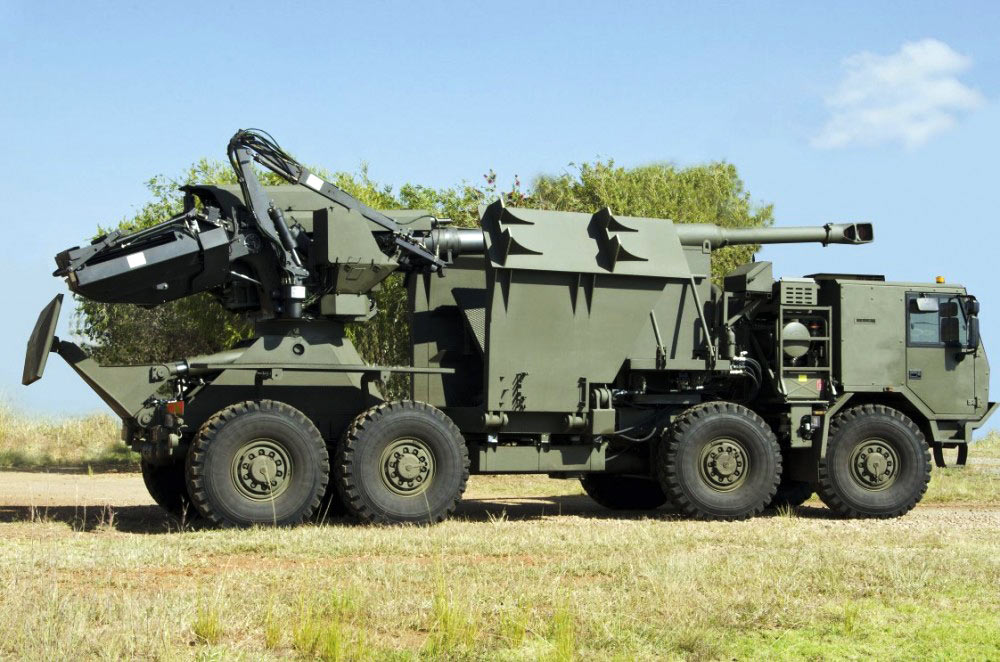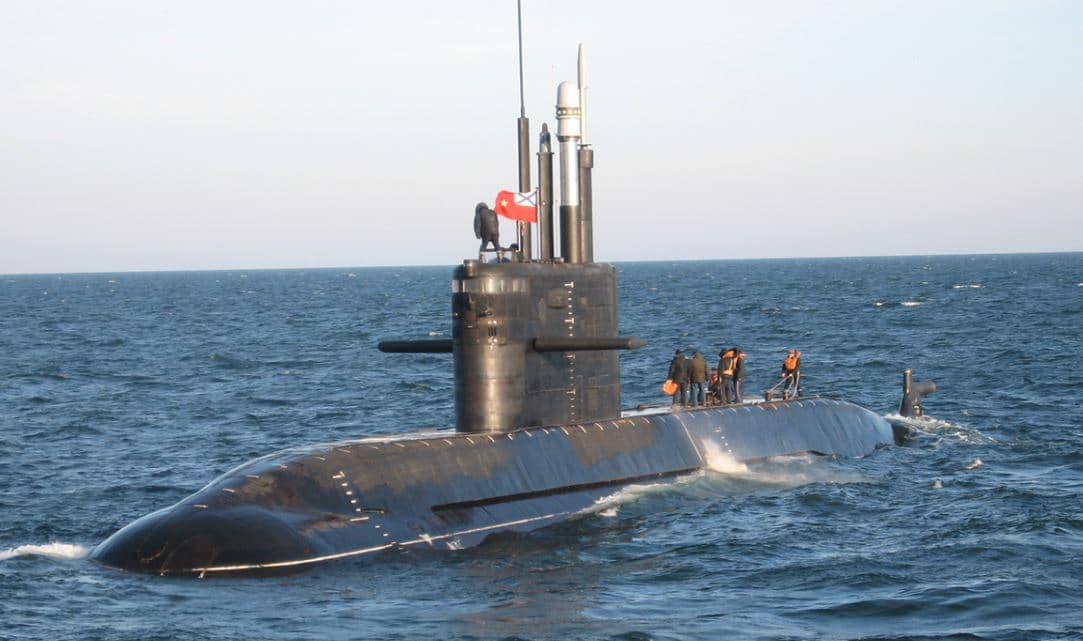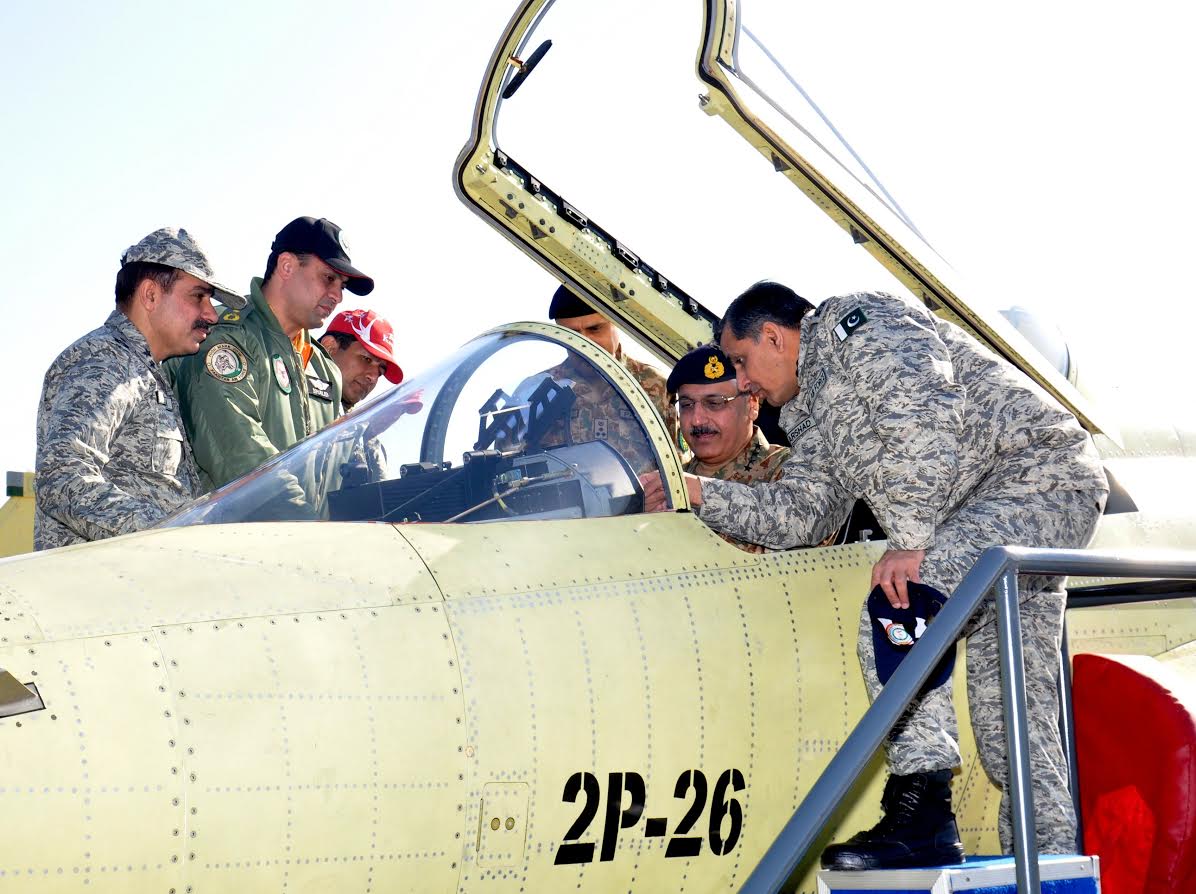2954Views 21Comments

Denel and Yugoimport-SDPR compete for Pakistan’s wheeled self-propelled howitzer requirement
South Africa’s Denel Land Systems and Serbia’s Yugoimport-SDPR are competing for the Pakistan Army’s requirement for a wheeled self-propelled 155 mm howitzer.
At the 2016 International Defence Exhibition and Seminar (IDEAS), which took place in Karachi last week, Denel Land Systems showcased and demonstrated its T5-52, a 155 mm 52-calibre gun mounted to the Czech Tatra T815-7 8×8 truck. The T5-52 is capable of firing standard, base bleed, and velocity enhanced shells to 30 km, 42.5 km, and 55 km, respectively (Denel Land Systems). The complete system weighs 38 tons and can travel at up to 85 km/h. It can travel up to 600 km without refuelling.
The Yugoimport-SDPR NORA B-52 is a lighter system at 28 tons, but it is also comprised of a 155 mm 52-calibre gun mounted to a Russian KamAZ 8×8 truck. The NORA B-52 can fire standard and base bleed shells to 20 km and 41 km, respectively (Army Technology). The NORA B-52 has a top travel speed of 90 km/h and range of 1,000 km without refuelling.
Notes & Comments:
The Pakistan Army has been seeking a wheeled self-propelled howitzer (SPH) since as early as at least 2008 when it procured two SH-1 howitzers from China for evaluation purposes. It is not clear if Pakistan acquired additional SH-1 units, though it would seem unlikely considering that these systems have not been verifiably spotted at national events or during major exercises.
Through the pursuit of wheeled armoured personnel carriers, utility helicopters, and wheeled SPHs, the Pakistan Army has been working to strengthen its rapid deployment and mobility capabilities. In terms of highly mobile artillery, the T5-52 and NORA B-52 are comparable platforms in many respects. The final selection will be dependent on the respective performance of these machines in the climate conditions the Pakistan Army envisages using these systems.



21 Comments
by Andrei Romanov
In every aspect Yugoimport-SDPR NORA B-52 is better than Danel T5-52. you can see yourself =
Yugoimport-SDPR NORA B-52 := https://en.wikipedia.org/wiki/Nora_B-52
Danel T5-52 := http://www.military-today.com/artillery/t5_52.htm
by Shakeel
Would it be be feasible for Pakistan to have a combination of both T5-52 & Nora B-52 in smaller quantities, pending on battlefield circumstances?
by Matthys Jacobs
As a South African and ex Denel, I would obviously be bias towards the T5-52. I would also prefer Pakistan had a closer relationship with Denel for future products such as collaboration on the A-Darter Missile, Umkhonto Missile, Al-Tariq Glide Bomb, Mokopa Missile, Rooivalk Helicopter, Modular Combat Turrets, the African Military Truck, Electronic Warfare suites and other technology.
In saying that, both wheeled self-propelled 155 mm howitzers are formidable.
Obviously the Denel T5 has a longer history based on the G5 which still holds the most records in terms of range.
I gather it will come down to pricing. Which I think the NORA B-52 will be able to win.
I can’t see Pakistan going wrong on any of the choices. Both gives them a good capability.
I have to be honest though, the NORA B-52 might take it due to the fact it has been exported to 3 other countries so production costs would be cheaper.
The truck based T5-52 although based on the G5 which is in use by several countries and has combat experience (Angola, Yemen, Iraq, Chile and Iran has tested it) has not been exported and although India tested it and reportedly favoured it.
I do think that Serbia has closer relations with Pakistan and the T5-52 will probably lose out. Also, Bangladesh currently uses the NORA B-52 which could offer some sort of commonality within the region.
by Matthys Jacobs
Ideally they would use the testing results from a stringent evaluation process to determine which platform to go with.
I would think the lowest quantity that each vendor would sell is around 12 to ensure that any sale wouldn’t be a smokescreen for IP theft.
Personally, I think either choice would give Pakistan a great capability.
by M. Naim Shaikh
I believe, Pakistan can benefit a great deal more by choosing T5-52, especially if South Africa could offset the cost by buying Pakistani made Supermushshak and JF17 as well as by offsetting with third party transfers with transfer of technology agreement.
by Steve
Totally agree. Apologies to all the professional on here but I’m not sure if Pakistan does not already have a system like this. Perhaps someone can enlighten us. We seem to have hundreds of artillery pieces, not sure how big the need for new airmobile artillery is especially as the road network in AJK is good. Looks like we are going in for heavier artillery useful in conventional battle in the plains. A light advanced air mobile system if we already don’t have it, coupled with ISR assets and Firefinder for targets out of line of sight will be very useful on the LOC. The ability to quickly bring enhanced firepower to the equation may prevent escalation if the enemy knows a burst of 155mm shells will land on them if they escalate. Need to remember the M777 buy across the border too. We don’t have to accept that we will lose out in any escalation. We can manufacture local numerical advantage at key points.
by Shakeel
Just like to thank Quwa for this article.
Also would like to welcome Andrei to Quwa.
Matthys Jacobs piece in response to the article is both informative & positive.
Matthys suggestion of a ‘one stop solution’ for procurement from Denel makes good rational sense, but his assertion that cost will determine the outcome is also a good indicator of which the pendulum might swing between Denel T5-52 & Nora B-52. Both system are ‘top notch’.
Based on recent acquisitions of big ticket items such as helicopters, fast crafts etc the Pak military has sourced their acquisitions from multiple vendors. In this context, I feel the Pak army should consider both systems, from which they yield tactical deployment synergies, because by employing both systems it should create uncertainty in the minds of the enemy in terms of effective countermeasures.
I am no expert in defence, but I feel cost alone should not be the sole determinant in making such purchases, because quality, geo-politics, artillary project range of 55 Km,reliability of source supplier, automation, accuracy etc are also factors which can also form the basis of any final decision. Given that our arch rival rival is ‘beefing up’ defences at a phenomenal pace, whatever decision we take should based on securing the territorial integrity of the country.
by nob hamid gul
Pakistan may buy the Chinese AH4 which is almost similar to the world’s most light artillery m777 produce by BAE system
M777 weight- 4200kg
AH4 weight- 4500 kg
India is getting 145 m777
by nob hamid gul
T5-52 OR Nora B-52 along with Chinese AH4 would be dangerous combination.
Admin pls write about Pakistan’s MRL system.
by Steve
Thanks nob! The review in Jane’s looks good. The maximum lift capacity of Mil Mi17 is 4500 kg so marginal. Don’t know if a helicopter can land in a hot sector though. http://www.janes.com/article/62341/china-completes-development-of-155-mm-ah4-howitzer
by Matthys Jacobs
Unfortunately I can’t see South Africa purchasing the JF-17 because we already have 26 SAAB JAS-39 Gripen’s, we’re struggling to fund that small number so it would be impossible to induct a second fighter.
Added to that, South Africa currently uses the Pilatus PC-7++.
However where South Africa where can definitely compete is transfer of technology which we have done in the UAE and Algeria.
The UAE now manufactures long range glide bombs based on South African technology.
by Matthys Jacobs
A good option could be Denel’s ultra lightweight 105mm towed howitzer which weighs under 2,500 kg and has a range of 36 km.
by Matthys Jacobs
General Dynamics of the US and Denel of South Africa ran a US funded study which proved that the lethality range of the Denel G7 is greater than the M-777.
Also the CEP was far lower in the 105 mm LEO.
The payoff is essentially fewer rounds expended to destroy a target and enhance logistical efficiency. Only 2 M-777’s can be transported in a C-130 whereas 4 of the Denel G7105 LEO could be transported in the C-130.
With different ammunition the G7 would probably outrange the M-777 as well as ease logistics tail by 80% less than the M-777.
by Matthys Jacobs
If cost was not an object then local development would always be preferable if the technological base.
I personally think Pakistan should partner with South Africa specifically with Denel on Vehicles, Artillery, Ammunition, Missiles and other Ordinances.
I think both nations have commonality and could thrive together.
I think Pakistan should also adopt the approach of Apartheid Era South Africa when it was faced with multiple enemies and far better equipped enemies.
by HARSH Aditya
India in all probability is purchasing 814 t5-52, bcoz denel has partnered TATA which is a heavy weight here and govt can’t ignore it. The deal will be valued around $2.6 billion.
by Matthys Jacobs
I doubt it since India has decided to proceed with its own Howitzer development.
It would of course be great for Denel.
by Keyser
The problem with some of the SA systems is whether they are sanction proof. I know that the Rooivalk didn’t get much traction because of the Imported elements. (IIRC it was the French engines)
I could be wrong on some of the other systems so feel free to correct me.
by Matthys Jacobs
So it depends on who the buyer is.
If it were to say Iran which is on a UN Security Council Sanction list, no country could sell to them. Russia of course could push the boundaries but then the companies involved would get sanctioned as well.
South Africa realised this years ago therefore it uses as much local developed components and commercial off the shelf components as possible.
South Africa unfortunately does not have the financial muscle to develop it’s own helicopter engines and gearbox, if properly funded and mandated it could but would face an uphill task of having to replicate what is already out there.
Because the Rooivalk uses common components from the Super Puma which is readily available one could argue it is less susceptible to US or EU based sanctions than say the Apache or Tiger or TAI/AgustaWestland T129 which has it’s roots in the Mangusta. If Turkey were ever sanctioned by the EU it would not be able to continue development within the involvement of Agusta. Whereas the Rooivalk could source common parts from Super Puma helicopters which are distributed throughout the world. South Africa proved this during the sanctions period.
Why Iran cannot do this is because it sourced the majority of its equipment from the US which actively seeked to destroy components of that equipment i.e. the F-14.
The Rooivalk tried to sell in Malaysia, Turkey, UK and Australia.
During Trials, the Rooivalk was selected as the top contender for the Malaysian contract for 28 units but due to pressure from the US on a early democratic South African government which required US assistance in funding the massive debt wracked by the previous Apartheid Government it had to concede not to sell to Malaysia. To be fair, Malaysia experienced the Asian Financial Crisis just before the deal was signed and it collapsed due to funding.
The Australian competition saw the Rooivalk emerge in the last two contenders with Australia selecting the Eurocopter (Now Airbus) Tiger. This is the only competition when Eurocopter as a consortium threatened Denel and prospective buyers by stating in competitions which had the Tiger as a prospect they would not guarantee component delivery for the Rooivalk. One could argue that this is unfair but at the time, Eurocopter faced huge pressure to drop their Attack helicopter programme and if we fast forward till today, Australia regretted their decision and is looking to scrap the entire fleet due to poor performance. It has never been deployed because the Tiger was designed as a smaller attack helicopter to say the apache.
The UK deal was always going to be a dud, the British used the Rooivalk as a means to reduce the cost of the Apache and to bring locally made Apaches to the UK.
Turkey was the final nail in the coffin of the Rooivalk. At that point South Africa reduced its initial order of 48 Rooivalks to just 12 which severely impacted the programme. Denel was also going through major financial restructuring at that point. Added to those troubles, the US banned integration of the HellFire Missile onto the Rooivalk fearing South Africa would reverse engineer it and having a strong competitor to the Apache given South African expertise in hot and high environments at the time. This was coupled to that fact that South Africa needed a minimum order of 45-60 units from Turkey to ensure the Rooivalk programme survived. Denel went through another restructuring during this time and Turkey viewed it as too high of a risk to go forward with Denel.
If we forward till today, Eurocopter is now owned by Airbus which is courting South Africa for a purchase for the A400M and C-295 and C-212 and A-330 MRRT. South Africa is a major user of Airbus Aircraft at the moment and Denel is a major manufacturer in the value chain for various Airbus lines. Because of this Airbus signed an agreement to always provide components to the current Rooivalk and any newly developed Rooivalk which would probably only be upgraded in terms of electronics and reliability.
The biggest hurdle facing the Rooivalk is a lack of a domestic anchor order. At minimum South Africa would need to commit to between 36 – 48 Rooivalk helicopters with a minimum export order of between 30 – 50 units to reopen the production line and keep pricing under the Apache and closer to the Mi-28.
A Rooivalk mk2 would offer invaluable IP to a country which uses it. Going with the Turkish option although perfectly fine would not have the sort of technology transfer such as a deal with Denel.
by Shakeel
Despite its setbacks the Rooivalk is a testamount to South African ingenuity.
South Africa produces some world class engineers from prestigious institions such as Stellenbosh University, Pretoria & Capetown. South African lacklustre political culture has not kept pace with the talented human resource potential in the country It’s a shame because Pakistan problems, although are more deep rooted in terms of ‘governance’, but i feel we can all learn a lot from South Africa’s positive achievements.
by Shakeel
Whilst not discounting importance of portable howitzer.Pakistan strength lies in mountainous terrain..Mobility will be vital against any multipronged attack in an open pasture attack. Given Pakistan lack of strategic depth, it would be well advised to guard their frontier from any possible point,
A degree of parity must be maintained at the LOC, but not at the expense of being outflanked elsewhere. Hedge the risk factors with the type, range & mobility of your artillery.
Thank you Sami & Steve.for your positive input.
by Matthys Jacobs
I think over the next few years, South Africa will be forced to have a political overhaul since fractures within the current ruling party will eventually lead to them losing power or forced into a coalition to stay in power.
The economy is also out of sync and we’ve failed to go into markets which offers the most advantage such as Sub Saharan Africa, Pakistan etc.